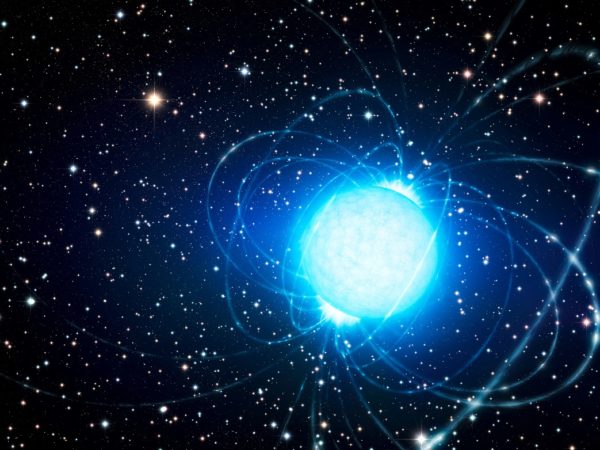

Astronomers are starting to fill in the blanks about a strange set of radio waves coming from outer space called fast radio bursts (or FRB’s).
A new study in the journal Nature looked at data from a recent FRB occurrence and concluded the source to be at least six billion light years from Earth. Further, the FRB was found to have travelled through a magnetic field and a “dispersing region” of thick plasma somewhere close to its point of origin.
Astrophysicist Kiyoshi Masui of the University of British Columbia and lead author of the study told Scientific American, “Our main result is that the source of the burst is surrounded by a region with a magnetic field and dense gas, like that of a star-forming nebula, a supernova remnant or a galaxy’s central region.”
These waves have proved a mystery since one was first identified in 2007 by David Narkevic, an undergraduate student at West Virginia University. Narkevic was analyzing data from the Parkes radio telescope in Australia when he found an odd reading of radio waves whose source seemed to be from outside the galaxy.
“Our first reaction was, what in the world is this?!” says Narkevic’s advisor, Duncan Lorimer, in an interview with journal New Scientist. “I didn’t expect to see anything out there at all.”
There’s a lot to wonder about FRB’s. They are incredibly intense bursts of energy – the same amount as the Sun puts out in a month – all compacted into a few milliseconds. Only a handful of FRB’s have been identified so far, though the speculation is that hundreds if not thousands of these events are arriving on Earth every day.
But just where are they coming from? Explanations range from collisions between black holes to random pulses from neutron stars to – you guessed it – intelligent life forms.
“Since the Lorimer pulse [in 2007], I’ve commented that these [FRB’S] could be engineered signals – in my case I just wondered if the engineers were extraterrestrial. More data will tell us what the right interpretation,” says Jill Tarter, astronomer at the SETI Institute in Mountain View, California, the organization dedicated to finding other life in the universe.
And while we’ll leave the real work on FRB’s to the astrophysicists, (co-author of the Nature study, Maura McLaughlin, says, “I do believe we are very close to solving this mystery”) how about we keep E.T. on the phone a little longer while we bring out a final quote, from Professor Matthew Bailes of Swinburne University in Melbourne, Australia.
Professor Bailes is currently heading the Breakthrough Prize Foundation’s search for alien life, a venture backed by Russian billionaire Yuri Milner and endorsed by Stephen Hawking.
While one would guess that Professor Bailes is excited by the prospect of making contact with other life forms, apparently this is not the case.
Bailes says that any alien life we find is likely from a world far more advanced than ours, and, truth be told, “The history of weak civilisations contacting more advanced civilisations is not a happy one.”
Can’t say we weren’t warned.
Leave a Reply
You must be logged in to post a comment.




 Share
Share Tweet
Tweet Share
Share




Comment